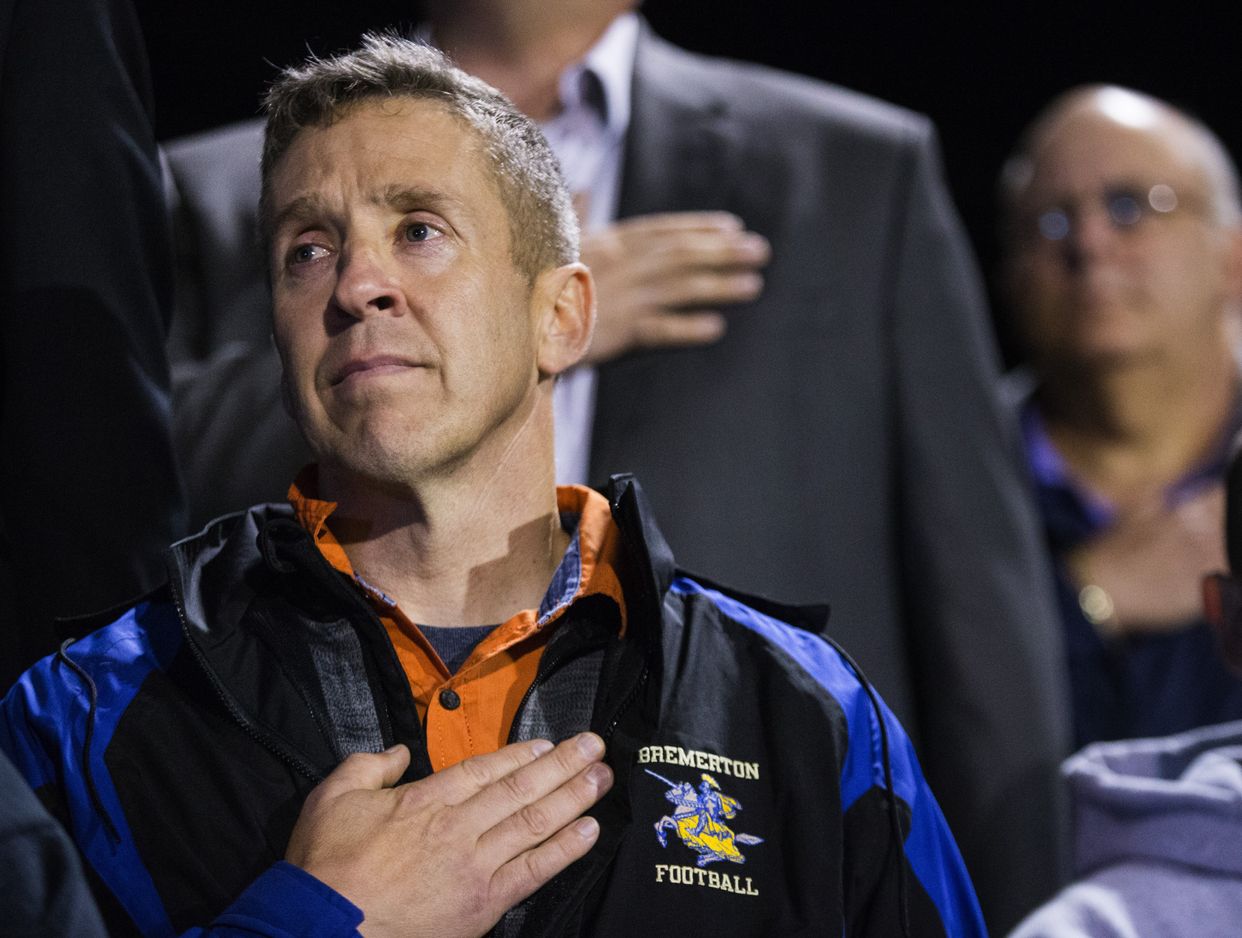 |
| Coach Joe Kennedy (Lindsey Wasson/The Seattle Times) |
Joe Kennedy, an assistant high school football coach, felt “called by God” to pray immediately after each of his team’s games, directly on the fifty-yard line. Soon, his prayer became a notable community event, garnering players and parents from both teams, and the attraction of local and national news.
After each game was over, “and after the players and coaches from both teams [ ] met to shake hands at midfield,” he proceeded to the fifty yard line of the field, knelt down, and engaged in about thirty seconds of silent prayer. Over the course of the years he coached from 2008 until 2015, more of his own players, as well as coaches, students, and parents, joined him in silent prayer. These then changed into “short motivational speeches” that included sectarian religious language. When Bremerton School District learned of this, they told Kennedy to stop the religious speeches, and that he must separate his religious exercise from the players. Kennedy followed the school’s orders for one game, but then proceeded to the same conduct as before. The coach gave multiple interviews to the news media, and after failed negotiations with the school to find common ground on religious conduct, the coach was placed on paid administrative leave, and his contract was not renewed at the end of the year.
Kennedy sued in 2016, stating that his rights to free exercise were violated by the district’s rules. Both the District Court for the Western District of Washington and the Court of Appeals for the Ninth Circuit agreed with the district, while the Supreme Court declined to hear the case. The case was sent back to the district court, and the Ninth Circuit wrote their second opinion on March 22nd.
 |
| A January 2021 interview with Fox News |
The Ninth Circuit ruled in favor of the district. In short, the Circuit said that because he was a coach, he would not have had access to his position on the field otherwise, and thus, “Kennedy’s position encompassed his post-game speeches to students on the field.” Additionally, the fact that he continually communicated his convictions to the news media, the Circuit said, was “a continuation of his on-field demonstrative activities… that were designed to attract publicity.” He’s continued to speak about his case, including writing a Fox News op-ed in January.
Additionally, the district did have a compelling interest in regulating Kennedy’s free speech and exercise, the Circuit said: as held in Good New Club v. Milford Central School, when some state tries to avoid some Establishment Clause violation, that in and of itself can constitute a compelling interest. The possible Establishment Clause violation? Kennedy’s prayers could have ended up coercing students towards some particular religious persuasion. Further, the speech was not private “in the context of Kennedy’s publicity leading up to it,” because of his choice of publication of the matter.
While I have reservations about part of the reasoning, I agree with the Circuit Court’s ruling in favor of the district. Ultimately, while the prayer indisputably began as a silent, individual exercise of religion, the actual “privacy” did not last throughout. The act of retooling the practice when the number and involvement of students increased inched the practice ever-closer to something that could become unconstitutional. Whether it’s the Supreme Court’s ruling against the reading of non-denominational prayers in Engel v. Vitale, private time set aside for prayer in Wallace v. Jaffree, or the student-led prayer in public schools in Santa Fe Independent School District v. Doe, ultimately, it’s clear that precedent stands against Coach Kennedy. While the free exercise of religion, as guaranteed under the First Amendment, is vital to the foundations of American democracy, Kennedy’s act treaded dangerously close to an unconstitutional establishment of religion, and as such, the school was well within their rights to end his employment.
The only part of the decision about which I have reservations is the negotiation process of which the district tried to find a solution with Kennedy. Ultimately, I do understand that those sorts of discussions are manifestations of the “least restrictive means” provision common to the strict scrutiny standard. Kennedy found that no sort of prayer was acceptable than on the fifty yard line, immediately after the game. Telling Kennedy that other options, spaces, and times could be made available to him, treads close to government prescription of religious practice. However, the case for the district is compelling enough in other ways (speech, publicity, etc.) that, ultimately, the Circuit ruled correctly in order to ensure the vital separation of church and state.





